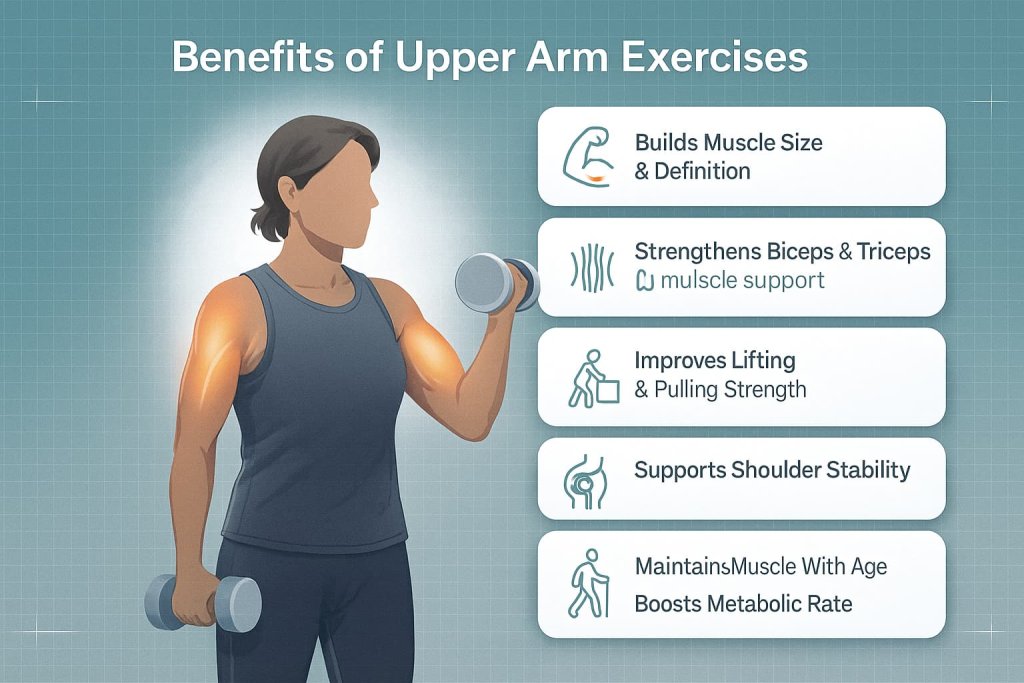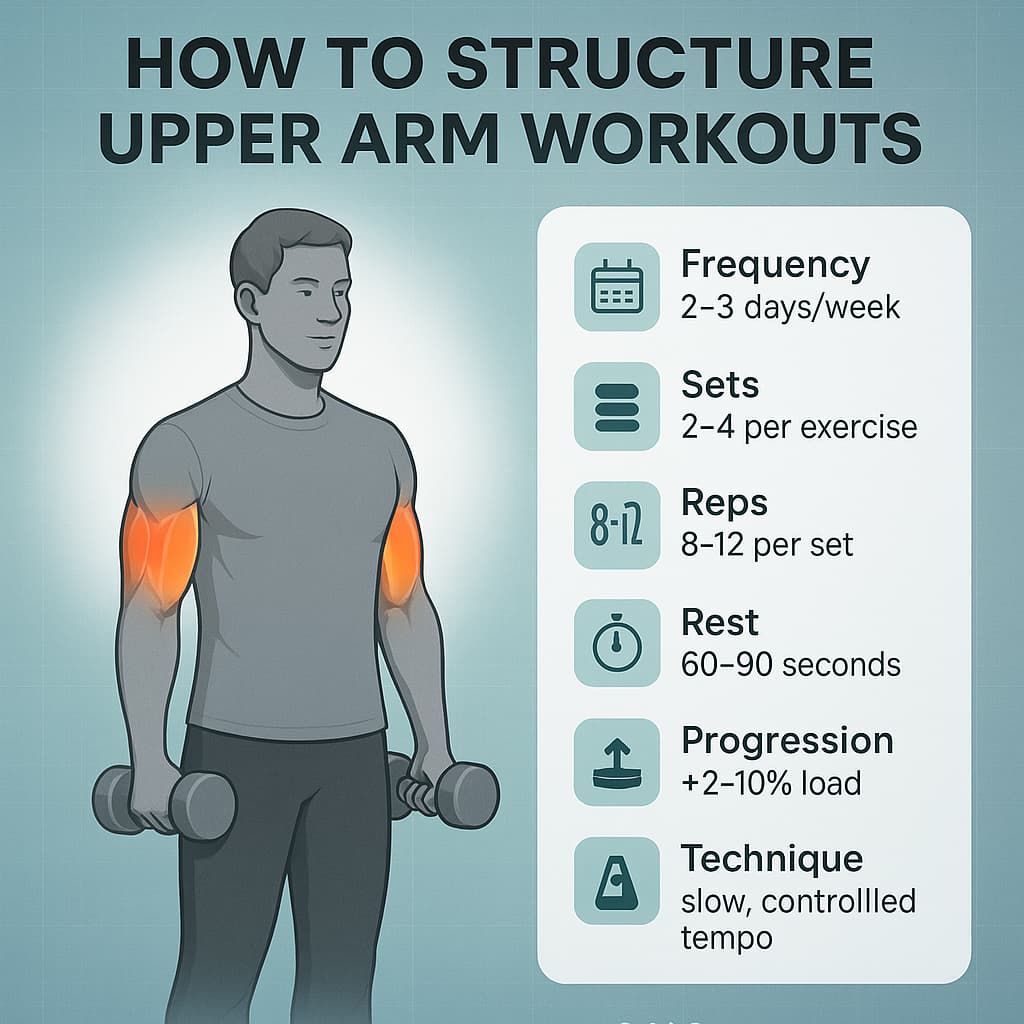If you want stronger, more defined arms, the best upper arm exercises are those that target both the biceps and triceps with controlled resistance training. These moves strengthen your biceps, brachialis, and triceps—the key muscles behind visible upper-arm shape and everyday strength.

Understanding how to train these muscles correctly helps you build size, tone, and definition without wasting time. In this guide, you’ll learn the 10 most effective upper arm exercises, how they work, proper form, ideal sets and reps, and safe progression tips.
Benefits of Upper Arm Exercises
Upper arm training offers noticeable benefits when performed consistently:
- Builds muscle size and definition
- Strengthens biceps, triceps, forearms, and supporting muscles
- Improves arm function for lifting, pushing, and pulling

- Supports shoulder stability and improved joint mechanics
- Enhances overall upper-body performance
- Helps maintain muscle mass with age
- Boosts metabolic rate by increasing lean tissue
How to Structure Upper Arm Workouts
- Frequency: 2–3 days per week
- Sets: 2–4 sets per exercise

- Reps: 8–12 for strength and definition
- Rest: 60–90 seconds between sets
- Progression: Increase weight 2–10% when reps feel easy
- Technique: Slow tempo, full but pain-free range
Warm-Up Before You Begin
A brief warm-up increases blood flow, prepares your joints, and helps prevent strain during upper arm exercises.
2–3 Minute Warm-Up:
- Arm circles – 20 seconds
- Shoulder rolls – 10 each direction

- Light marching – 20–30 seconds
- Biceps stretch – 10–15 seconds
- Elbow flexion/extension – 15 reps
Trainer Tip:
Keep movements gentle and avoid pushing into pain.
10 Best Upper Arm Exercises
Building strong, defined upper arms requires exercises that target both the biceps and triceps through controlled, effective movement patterns. These ten proven exercises help increase strength, muscle tone, and overall arm performance for all fitness levels.
1. Dumbbell Biceps Curl
Why it works:
This classic movement directly isolates the biceps, allowing you to build size, strength, and definition with precise tension. Because you control both the lifting and lowering phases, it improves muscle fiber recruitment and helps develop symmetrical arm strength.
Muscles worked:
Biceps brachii, brachialis, brachioradialis (forearms).
How to do it:
- Stand tall with dumbbells resting at your sides.
- Keep elbows fixed close to your ribs to prevent shoulder involvement.
- Curl the weights upward in a smooth arc toward your shoulders.
- Pause briefly at the top without letting elbows flare.
- Lower slowly for 2–3 seconds to maximize muscle tension.
Trainer Tip:
Focus on squeezing the biceps at the top and avoid swinging the torso. The slower the lowering phase, the better the results.
2. Hammer Curl
Why it works:
The neutral-grip position shifts more load to the brachialis and forearms, creating thicker-looking upper arms. It also reduces wrist strain and helps improve grip strength.
Muscles worked:
Brachialis, biceps brachii, brachioradialis (forearms).
How to do it:
- Hold dumbbells at your sides with palms facing inward.
- Keep elbows tight to your body as you curl upward.
- Lift until your forearms are vertical, then pause.
- Lower under control back to the starting position.
Trainer Tip:
Do not twist your wrists. A strict, straight-up-and-down path gives the best arm activation.
3. Incline Dumbbell Curl
Why it works:
By leaning back, the biceps are stretched more at the shoulder, forcing them to work harder from a lengthened position. This increases muscle tension and can enhance peak development.
Muscles worked:
Biceps long head, brachialis.
How to do it:
- Set an incline bench to 45–60 degrees.
- Sit back with arms fully extended and dumbbells hanging down.
- Keep shoulders pulled back and chest open.
- Curl the weight up slowly without lifting your elbows.
- Lower until your arms are fully stretched again.
Trainer Tip:
If your shoulders roll forward, the biceps lose tension. Stay tall and maintain a strong upper-back position.
4. Preacher Curl
Why it works:
The preacher pad eliminates momentum, isolating the biceps and increasing time under tension. This encourages strict form and stronger “peak contraction.”
Muscles worked:
Biceps brachii, brachialis.
How to do it:
- Sit at the preacher bench and place upper arms firmly on the pad.
- Hold the bar or dumbbell with arms fully extended.
- Curl upward slowly until your forearms are vertical.
- Lower all the way down for a complete stretch.
Trainer Tip:
Avoid bouncing at the bottom, as this reduces effectiveness and increases injury risk.
5. Chin-Up (Underhand Grip)
Why it works:
The underhand grip places more emphasis on the biceps than overhand pull-ups, while also engaging upper back muscles. This creates a powerful compound move that boosts both size and strength.
Muscles worked:
Biceps brachii, lats, upper back, forearms.
How to do it:
- Grab the bar with an underhand shoulder-width grip.
- Pull your chest up toward the bar, keeping elbows tight.
- Pause briefly at the top.
- Lower yourself slowly until arms are fully extended.
Trainer Tip:
Use a resistance band for assistance if you cannot complete full reps with proper form.
6. Close-Grip Bench Press
Why it works:
This variation shifts more load to the triceps compared to a standard bench press. It builds pressing strength and thickens the back of the arms.
Muscles worked:
Triceps, chest, anterior deltoids.
How to do it:
- Lie on a bench and grip the bar slightly narrower than shoulders.
- Lower the bar to mid-chest while keeping elbows close.
- Press the bar upward in a straight line.
- Lock out gently without snapping the elbows.
Trainer Tip:
A grip that’s too narrow stresses your wrists—use shoulder-width spacing for safe triceps focus.
7. Triceps Pushdown (Cable or Band)
Why it works:
Provides consistent tension through the entire movement and targets all three triceps heads. It’s joint-friendly and easy to learn.
Muscles worked:
Triceps long head, medial head, lateral head.
How to do it:
- Stand tall holding the rope or bar attachment.
- Keep elbows pinned to your sides.
- Push downward until arms are fully straight.
- Slowly return to the starting position without letting elbows drift.
Trainer Tip:
If your shoulders sway forward or backward, you’re using too much weight. Reduce load to maintain perfect form.
8. Overhead Triceps Extension
Why it works:
The overhead angle places the long head of the triceps under maximum stretch, making it a top-tier mass-building exercise.
Muscles worked:
Triceps long head (primary), medial and lateral heads (secondary).
How to do it:
- Hold one dumbbell with both hands overhead.
- Drop the weight behind your head by bending your elbows.
- Keep upper arms still as you extend back up.
- Maintain a slow, controlled rhythm.
Trainer Tip:
Engage your core and keep ribs down to prevent lower-back arching.
9. Triceps Kickback
Why it works:
This exercise isolates the triceps in the fully shortened position, creating strong peak contraction and improving arm definition.
Muscles worked:
Triceps (all heads, especially lateral head).
How to do it:
- Hinge forward at the hips with a flat back.
- Hold the dumbbell with your upper arm parallel to the floor.
- Extend your forearm backward until your arm is straight.
- Lower slowly to maintain constant tension.
Trainer Tip:
Use a lighter weight. Heavy loads cause swinging and reduce triceps activation.
10. Bench Dips (or Chair Dips)
Why it works:
A simple bodyweight exercise that effectively targets the triceps and builds pressing strength without equipment.
Muscles worked:
Triceps, shoulders, chest.
How to do it:
- Place hands behind you on a bench or chair.
- Extend legs forward with feet on the floor.
- Lower your body by bending elbows to about 90 degrees.
- Press back up until arms are straight.
Trainer Tip:
Keep shoulders away from your ears and avoid dropping too low to protect your shoulders.
Sample Upper Arm Workout
Beginner:
- Biceps curl – 2×10
- Triceps pushdown – 2×12
- Hammer curl – 2×10
- Overhead triceps extension – 2×12
Intermediate:
- Chin-ups – 3×6–8
- Close-grip bench press – 3×8
- Incline curls – 3×10
- Pushdowns – 3×12
Advanced:
- Chin-ups – 4×6
- Close-grip bench – 4×6–8
- Preacher curls – 4×8–10
- Overhead triceps extension – 3×12
Safety Tips
- Move slowly and avoid swinging.
- Keep wrists neutral during curls and presses.
- Avoid locking elbows aggressively.
- Stop if you feel sharp pain, numbness, or tingling.
- Consult a professional if you have shoulder, elbow, or cardiovascular conditions before starting a new exercise routine.
FAQs
1. How often should I train my upper arms?
2–3 times per week with at least 48 hours of rest between sessions.
2. Do I need heavy weights to build defined arms?
No. Moderate weights with good form and slow tempo work effectively.
3. Are chin-ups better than curls for biceps?
Both are effective. Chin-ups recruit multiple muscles, while curls isolate the biceps.
4. How long does it take to see visible arm definition?
Most people notice changes in 4–8 weeks with consistent training.
5. Can beginners do all these exercises?
Yes—start with lighter weights or band-assisted variations.
6. Are dips safe for shoulders?
Yes if done with good form. Avoid lowering too deep.
7. Can I build strong arms at home without equipment?
Yes—use bands, bodyweight dips, push-ups, or backpack-loaded curls.
Conclusion
Upper arm training doesn’t need to be complicated—just consistent, controlled, and focused on proven movements. By combining biceps and triceps exercises, following proper technique, and progressing gradually, you can build stronger, more defined arms at any fitness level. Aim for 2–3 sessions per week, use a slow tempo, and prioritize form over heavy weight.
If you’re ready to improve strength, tone, and everyday arm function, start incorporating these exercises into your weekly routine today. Your arms will get stronger, and your overall upper-body performance will follow.
This content is for informational purposes only and not medical advice.
References
- American College of Sports Medicine. “Progression Models in Resistance Training for Healthy Adults.” Medicine & Science in Sports & Exercise. 2009.
https://www.sportgeneeskunde.com/wp-content/uploads/ACSM-Position-Stand-Progression-Models-in-Resistance-Training-for-Healthy-Adults.pdf - American College of Sports Medicine. “Resistance Training for Health and Fitness.” ACSM educational handout.
https://www.prescriptiontogetactive.com/static/pdfs/resistance-training-ACSM.pdf - Momma H, et al. “Muscle-strengthening activities are associated with lower risk of mortality: a systematic review and meta-analysis of cohort studies.” British Journal of Sports Medicine. 2022.
https://bjsm.bmj.com/content/56/13/755 - Oliveira LF, et al. “Effect of the shoulder position on the biceps brachii EMG in different dumbbell curls.” Journal of Sports Science & Medicine. 2009.
https://pmc.ncbi.nlm.nih.gov/articles/PMC3737788/ - Parpa K, et al. “An Exploratory Study of Biceps Brachii Electromyographic Activity During Different Biceps Exercises.” Human Movement and Exercise Science (MDPI). 2025.
https://www.mdpi.com/2813-0413/4/4/45
